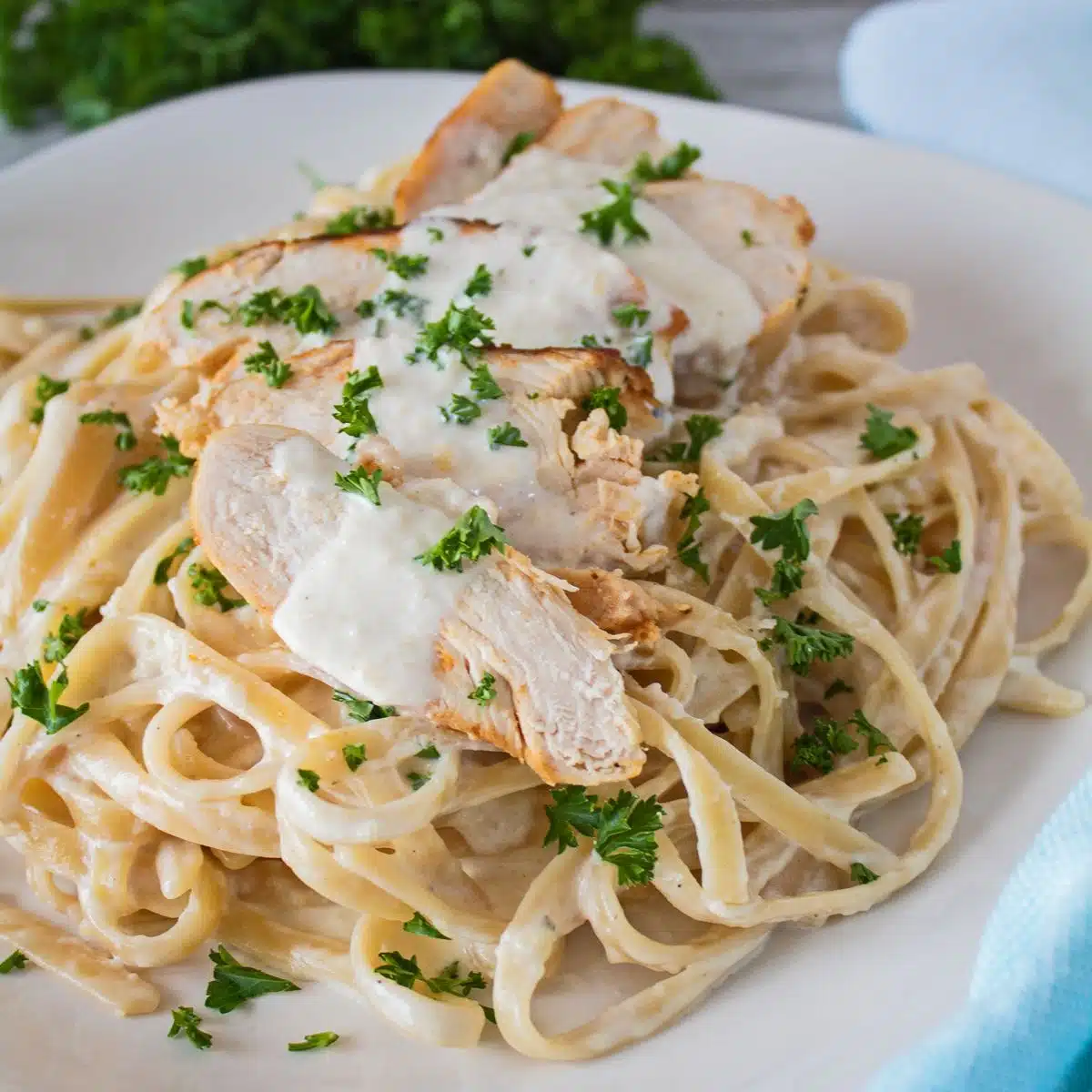Carbonara vs Alfredo: Everything you need to know about these two classic Italian sauces, including what makes them unique as well as all their similarities. Both pasta sauces are known for making deliciously creamy pasta dishes that are loved by all. From history to ingredients to everything in between, here's what you need to know!
Comparing Carbonara and Alfredo
Carbonara and alfredo are both creamy, white sauces in Italian cuisine that are enjoyed as satisfying meals in home kitchens and fine dining restaurants alike. Antidotes to the typical tomato-based sauces (such as marinara and arrabbiata), there are a few notable similarities and differences that make these two distinct sauces unique.
So what makes these sauces different, and what do they have in common? This article will go over everything you need to know about these popular sauces!

Jump to:
Check out my tasty smoked salmon fettuccine alfredo, garlic shrimp alfredo bake, or slow cooker chicken alfredo for deliciously creamy dinner ideas!
What is Carbonara Sauce?
Carbonara is complex and savory, typically served with spaghetti, and was also the traditional dish of Rome after World War II (WWII). Thought to be invented by Renato Gualandi, along with other Italian cooks working with the allies, it was served as a dinner for the U.S. Army.
It is made with egg yolks, guanciale (cured pork cheek), black pepper, and Pecorino Romano or Parmesan cheese. Pancetta (pork belly) is also commonly used for its sharp, salty taste and to cut through the creaminess.
Carbonara does not utilize cream. Its creaminess is the result of the egg yolks emulsifying with the cheese and some of the starchy water used to cook the pasta, giving it a thick and creamy texture.
There is also a delightfully smokey flavor derived from the pancetta or guanciale. The inclusion of garlic is optional and up to the cook's personal choice.
What Is Alfredo Sauce?
Alfredo is a thick and creamy sauce made from a base of butter and heavy cream mixed with Parmesan cheese. Some recipes call for garlic to be sautéed with the butter and cream.
Typically served with fettuccine, any long pasta noodle can be substituted based on your preference. Short pasta works well, too, but opt for pasta that will hold the sauce, such as penne or rigatoni.
Versatile and easy to make, alfredo sauce pairs well with bitter greens such as kale or broccoli. Its mild, buttery flavor also goes well with mushrooms, chicken, or shrimp. Pretty much any protein will make this saucy pasta a meal.
White wine, such as Pinot Grigio, or red wine, such as Pinot Noir, go best with this satisfying meal.
>>>>See all of my recipes here<<<<
Authentic Italian Alfredo And American Alfredo
There is a difference between authentic Italian Alfredo and American Alfredo.
The authentic Italian version was invented by Alfredo Di Lelio, who worked at a restaurant in Piazza Rosa. He came up with the dish in the early 1900s to entice his wife to eat after giving birth to their first child.
It is made by tossing fettuccine with butter and Parmigiano Reggiano. As the cheese melts, it emulsifies with the butter to create the creamy consistency of the dish and seasoned to taste with cracked black pepper.
American Alfredo sauce is made with butter, heavy cream, and Parmesan cheese. Some recipes call for sautéed garlic and/or the addition of Romano cheese (my personal favorite stir-in).
Differences Between Carbonara and Alfredo
While these white sauces are rich and creamy and originate in Italy, there are some distinct differences to both.
- Ingredients: Each sauce utilizes hard cheeses like Parmesan or Pecorino Romano, and carbonara relies on egg yolks for its creaminess. Alfredo relies on heavy cream. Carbonara also calls for pancetta (or guanciale) for extra saltiness, whereas alfredo has a milder taste (because of the cream) and can be served with chicken or shrimp. Many chefs use ground black pepper to garnish carbonara versus fresh parsley for alfredo.
- Cooking Process: Alfredo's butter and heavy cream must be cooked in a saucepan. Carbonara requires pasta to be tossed in butter and a bit of pasta water, then rendered with pancetta, raw eggs, and grated cheese.
- Flavor: Carbonara lends its sharp, salty taste to the pancetta that cuts through the creaminess. Alfredo is creamier, richer, and milder.
- Pasta: Fettuccine is most popular with alfredo, and spaghetti for carbonara.
Table 1: Pasta Sauce Comparison
| Component | Italian Alfredo | American Alfredo | Carbonara |
|---|---|---|---|
| Ingredients | Pasta water, pasta, butter, Parmigiano Reggiano, cracked black pepper | Heavy cream, butter, Parmesan cheese, pasta | Pasta, butter, pasta water, egg yolks, guanciale or pancetta, Parmesan or Pecorino Romano cheese |
| Cooking | Cooked pasta is tossed with butter and cheese. | Pasta and sauce are cooked separately and then combined. | Cooked pasta is tossed with starch water and butter, and then egg yolks, pancetta, and cheese are mixed. |
| Pasta | Typically fettuccine | Typically fettuccine | Spaghetti |
| Flavor | Rich & creamy | Mild, rich & creamy | Salty, rich & creamy |
Which is Better?
Both carbonara and alfredo are delicious Italian dishes that are comforting, satisfying, simple, and easy to make. While they share some similarities, such as being made with Parmesan or Pecorino Romano, they have unique differences that give each their distinct flavor and texture.
So the choice really comes down to preference of taste. Whether you like the sharper, saltier taste of carbonara, or the light, buttery taste of alfredo, both sauces will satisfy your craving for Italian cuisine.
And if you go with alfredo, don't forget to try the authentic Italian version!
🤌🍝🍕 Tasty Italian Recipes
- Pesto Sauce - Another classic Italian sauce utilizing tender, fresh young basil leaves combined with Parmesan cheese and pine nuts.
- Eggplant Parmesan - Thinly sliced eggplant baked with a crispy coating and assembled to make this classic casserole!
- Frutti di Mare - This is one of my all-time favorite seafood pasta dishes that you're sure to love too!
- Calamari - Crispy, fried calamari rings are the perfect appetizer for your alfredo or carbonara pasta dishes!
- Pastina Soup - Simple chicken pastina soup is the Italian version of chicken noodle soup, and it's just as good!
- Antipasto Platter - Dish up a full antipasto spread before a hearty pasta meal or a smaller version for a lighter family dinner!
Now that you know the distinct differences between these classic Italian sauces, let me know which one you like best in the comments below!
Do you love a recipe you tried? Please leave a 5-star 🌟rating in the recipe card below and/or a review in the comments section further down the page.
Stay in touch with me through social media @ Pinterest, Facebook, Instagram, or Twitter! Subscribe to the newsletter today (no spam, I promise)! Don't forget to tag me when you try one of my recipes!
📖 Recipe Card
Carbonara vs Alfredo: Homemade Alfredo Sauce (A Complete Comparison of The Italian Sauces)
Ingredients
- ½ cup butter
- 1 Tbsp garlic (finely minced)
- 2 cup heavy cream
- ¼ teaspoon each, salt & pepper
- ½ teaspoon garlic powder
- 1 cup Parmesan cheese
- ¼ cup Romano cheese
(Note: 2x or 3x only changes the ingredient list)
Instructions
- In a medium skillet or frying pan, melt your ½ cup butter while the pan heats to a medium heat. Add the 1 tablespoon garlic when the butter is about halfway melted, and allow to cook while the butter continues to melt.
- Once the butter is completely melted, add the 2 cup heavy cream and seasoning (¼ teaspoon each, salt & pepper, ½ teaspoon garlic powder). Stir to combine and bring the sauce mixture to a low boil.
- Then once the sauce mixture has reached a low boil, reduce the heat and allow to simmer for about 5 minutes.
- Slowly stir in the 1 cup Parmesan cheese and ¼ cup Romano cheese, and continue to stir until the cheese is thoroughly melted and combined into a creamy, smooth alfredo sauce (about 2-3 minutes). Remove from heat and serve over your favorite pasta immediately.
Notes
- If time allows, letting your cream come up to room temperature for 30 minutes before making your sauce will help it blend more efficiently and reduce your cooking time.
- Alfredo sauce pairs best with shrimp, chicken, or fish, though you can certainly try it with other proteins!
- Dairy is a crucial ingredient for making a creamy and authentic alfredo sauce. If you are dairy-free, rather than making substitutions here, I would recommend you follow a specific recipe for dairy-free alfredo.



Comments
No Comments